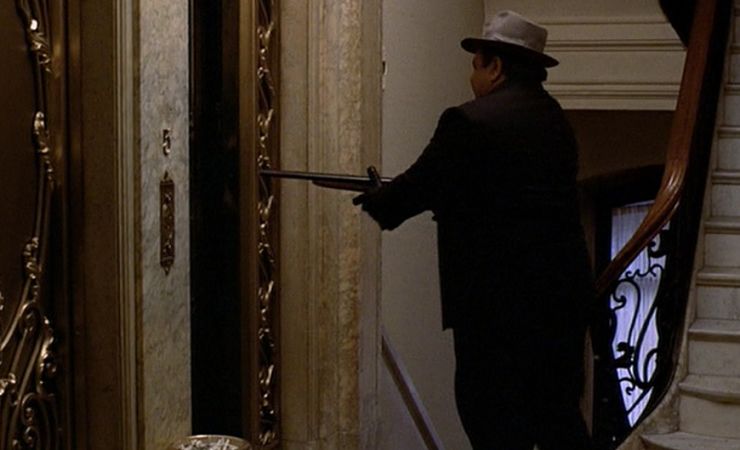Finding Fault with Faux Facts

As I teach the students in my litigation courses, the use of vivid details will always make a case more convincing. Can the witness to an accident describe the dark color of an automobile or the screech of its brakes as it wheeled around a corner? “Screech” and “wheeled” – rather than “sound” and “turned” – are small examples of using vivid details to dramatize events; the more precise verbs underscore the accuracy of the witness’s perceptions, while allowing the fact finder to re-imagine the sequence of events. It would be even better if the witness could identify the car’s particular shade, rather than a generic color, especially if it is unusual.
My coauthor and I explain this in Modern Trial Advocacy (2020, p. 32): “Using details can turn a bald claim into a reasoned, logical, well-founded proposition.” Here is an example of how that can work, taken from a Wikipedia entry:
Shotgun Man was an assassin and spree killer in Chicago, Illinois in the 1910s, to whom murders by Black Hand extortionists were attributed.[1] Most notably, Shotgun Man killed 15 Italian immigrants from January 1, 1910 to March 26, 1911 at “Death Corner,” the intersection of Oak Street and Milton Avenue (now Cleveland Avenue) in what was then Chicago’s Little Sicily.[2] In March 1911, he reportedly murdered four people within 72 hours.[3]
The first sentence is a general claim, if not quite a bald one, about a mysterious assassin known as “Shotgun Man,” active in the 1910s, whose scary story might ordinarily be in doubt. His existence is more firmly established – especially in the context of Chicago’s well-known history of gangland murders – by the addition of the successive details. We have his motive, which was to facilitate “Black Hand” extortion of Italian immigrants. We have the duration of the murder spree, including the number of victims, right down to specific beginning and end dates. We have not only the neighborhood, with its origin embedded in the evocative designation “Little Sicily,” but also the exact intersection where the crimes took place, identified by its own macabre epithet. We even have the renaming of Milton Avenue as Cleveland Avenue, a verifiable historical fact. Finally, there are footnotes with links to reliable sources: Griffith, American Mafia: Chicago: True Stories of Families Who Made Windy City History and Sifakis, The Mafia Encyclopedia.
The only problem is that the story is untrue. According to the better-researched Wikipedia entry for Urban Legends,
Shotgun Man is an urban legend of organized Crime: as an assassin and spree killer in Chicago, Illinois in the 1910s, to whom murders by Black Hand extortionists were attributed. . . .[17] However, a check of the Northwestern University website on “Homicide in Chicago” shows shotgun killings in Chicago – but none in Jan-March 1911-and only one killing at Oak and one at Milton Streets between 1900 and 1920.
The “Homicide in Chicago, 1870-1930 “website was created by Northwestern’s Chicago Historical Homicide Project, under the direction of my colleague Leigh Bienen (I had no involvement). The comprehensive list of over 11,000 homicides in Chicago was compiled through a painstaking search of sixty years of handwritten records. The project then transcribed the original police and coroner’s reports into Word documents, resulting in a searchable data base that allows fact-checking of the Wikipedia entry on Shotgun Man.
In other words, colorful details will always make a story more compelling, but they may not always be true. In important matters, verification is essential.
In litigation, there are both ethical and procedural constraints on the use of fabricated or contrived details. The Rules of Professional Conduct prohibit lawyers from making, or even failing to correct, false statements, or offering evidence known to be false. Should that fail, cross examination is available to expose deceptions, exaggerations, or undue embellishments.
Other disciplines, including some social sciences, follow less rigorous conventions, with no prohibition against embellishing facts and no strong tradition of fact-checking. In ethnography, it is not unusual for authors to mask their research locations, “deidentify” or anonymize their research subjects, remove and alter details such as dates and locations, build composite characters, or even “portray a single participant as multiple characters,” while often failing to distinguish direct observations from hearsay accounts, all in the name of preserving confidentiality.
These practices can make verification nearly impossible. Worse, they lead to the production of faux facts – details that are added to a story for the sake of dramatization, but which the ethnographer could not actually have observed or substantiated.
A clear example of such faux facts can be seen in Sudhir Venkatesh’s widely read ethnography Off the Books (2006). A gifted narrator, Venkatesh powerfully relates the story of a small-time Chicago drug dealer named “Babycake Jackson,” who unwisely refused to keep working as a lookout for a major supplier. In retaliation, Babycake was murdered while he was asleep in an abandoned building. In Venkatesh’s account, the murder occurred in February 2002 in the “Maquis Park” neighborhood, which his endnotes reveal to be the vicinity of 47th Street and Martin Luther King Drive. Although his information is at best second-hand – perhaps coming from Babycake’s brother Bill, who was the source for other particulars – Venkatesh adds the compelling detail that the murderers shot their sleeping victim a horrific 22 times.
As with Shotgun Man, however, there was actually no such murder in Chicago. According to the city’s homicide records, there was a strangulation in an abandoned building in February 2002, but the victim was a woman and the murder occurred miles away from “Maquis Park.” There were some fatal shootings in Maquis Park that month, but none at night in an abandoned building.
There are seven potentially faux details in Venkatesh’s Babycake story: the date of the killing, the location, the reasons, the perpetrators, the manner of death (shooting), the number of shots, and the fact of the murder itself. We know that at least the date or location, or both, of Babycake’s demise have been misrepresented, and there is no way to determine which of the other facts in the story were invented or exaggerated by Venkatesh or his undisclosed source.
Most questionable is the statement that Babycake was shot twenty-two times, which is information that could have been accurately obtained only from the murderer (whom Venkatesh does not claim to have interviewed) or the medical examiner (whose records include no such shooting).
Thus, we have a classic example of a faux detail. It brings realistic punch to the story of life in Maquis Park, but it could not have occurred as told and it has no credible source. The lurid detail – 22 shots while the victim slept – adds a dramatic flourish, but at the cost of reliability. The truth is that we have no way of knowing exactly how or why Babycake met his end, or if he ever even existed as an individual rather than a composite.
Venatesh is far from alone among ethnographers whose potentially faux details – based on composites, rumors, or hearsay – are impossible to distinguish from real ones. Ethnography would therefore benefit greatly from developing a more vigorous culture of reciprocal fact checking. Regrettably, calls for such a practice have often been rejected, most recently as “privileging the ‘truth’ [over] our subjects’ perceptions and experiences.”
Speaking of truth, one of the sources for the “Shotgun Man” Wikipedia entry does indeed attribute 15 murders to a “Mafioso hit man,” including the dates of the alleged killing spree at the intersection known as Death Corner. The other source, however, recognizes that the story is part-myth and part-exaggeration. There were plenty of murders in Little Sicily in the 1910s, one of them, in an odd coincidence, occurring in a basement stairwell near Oak and Milton. But blaming the many deaths on “one lone Shotgun Man is mostly a modern creation,” based on a single old newspaper report about a lower-case “shotgun man” who was seen leaving the scene of a crime.
In the early 20th century, the recent immigrants in Little Sicily may well have been intimidated by extortionists’ threats to unleash Shotgun Man, which would account for his persistence among Chicago’s gangland urban legends. Likewise, the “perception and experiences” of contemporary Maquis Park residents – including second-hand stories of a bullet-ridden body – may inform an ethnographer’s understanding of the lurking dangers of drug dealing. But no matter how exquisite the details, it is important to separate fact from folklore – which should not require cross examination. Wikipedia’s vigilant editors have developed a protocol for revising erroneous entries and correcting faux facts. Ethnographers ought to do the same.






























































































